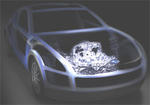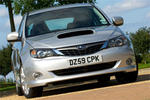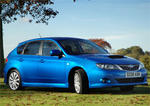
The Japanese carmaker has announced today that they have developed the new generation 2010 Subaru boxer engine which will be available as a 2.0-liter. From what we can understand from the official press release, the 2010 Subaru boxer engine will also be offered as a 2.5-liter on the carmaker's home market. This could be very good news for the STI owners. We had various reports of engines melting down in the 2008 Impreza STI. Some owners are at the third engine right now, on 2008 STIs. The new 2010 Subaru boxer engine might be able to solve this issue.
Here are the facts, the new 2.0-liter horizontally-opposed 4 cylinder DOHC 2010 Subaru boxer engine has 1,995cc of displacement, which is 1cc more than the current version.
The output of the new 2.0-liter 2010 Subaru boxer engine is rated at 109kW and 196Nm. The new unit has a 84 x 90mm bore x stroke in comparison to the previous version which has 92 x 75mm.
Currently, there are no details available regarding the Japanese market 2.5-liter 2010 Subaru boxer engine.
The major upgrades brought by the new 2.0-liter 2010 Subaru boxer engine include a longer stroke,
a compact combustion chamber, lighter moving parts, a cooled exhaust gas recirculation system, an intake/exhaust Active Valve Control System, a Tumble Generator Valve (TGV) and a compact oil pump.
Subaru Press Release:
Fuji Heavy Industries Ltd. (FHI) has developed its new-generation boxer engine* that combines the technology and know-how used in Horizontally-Opposed Boxer engines, the core technology that has supported Subaru's unique driving since it was first employed in the Subaru 1000 in 1966.
This overall renewal is the first in 21 years, since the second generation boxer engine was introduced in the first Legacy models in 1989.
This new-generation Horizontally-Opposed 4 cylinder gasoline engine, the third generation Subaru boxer engine, showcases Subaru's latest engineering research and development. It offers a new performance level by further refining Subaru's unique expertise in Boxer engine technology. The engine was entirely renewed, starting from the basic structure, while all the advantages of the
horizontally-opposed layout were maintained: lightweight, compact, low center of gravity, and superior vibration balance. New-generation improvements include advances in both environmental friendliness, such as an approximately 10% improvement in fuel efficiency, and driving performance for smooth acceleration in all speed ranges. Furthermore, FHI designed the new engine with consideration of the technology's expandability and potential capability to receive further upgrades meeting future environmental measures.
FHI built a new factory at the Gunma Oizumi Plant exclusively for the production of this new-generation boxer engine. This new plant offers state-of-the-art production facilities that make
full use of FHI's engine manufacturing know-how developed to date, as well as a highly efficient production system delivering products meeting the highest quality standards.
* Boxer engine : Also known as a Horizontally-Opposed engine. In this design, the pistons are arranged symmetrically left and right along the crankshaft. When the pistons move, they resemble the punches thrown by boxers, thus resulting in this popular name.
Major Features of the New-generation Subaru Boxer engine]
The overall structure of this engine has been totally renewed,
by reviewing the bore and stroke for the basic structure to allow a longer stroke than current engines. It is designed to achieve high efficiency in basic performance, allowing the smooth and sporty rotational properties for which Horizontally-Opposed engines are known, while also making improvements in practical torque and environmental friendliness. This engine is available with 2,500 cc or 2,000 cc displacement, both with 4 cylinders. These models will now be positioned as our main engines.
The bore and stroke, the basic structure of this engine, have been reviewed to achieve a compact combustion chamber as well as a long stroke, which was difficult previously due to chassis mounting conditions in boxer gasoline engines. This allows high combustion efficiency, and generates a sufficient mid-low speed torque with improved fuel efficiency and practicality.
Improved fuel efficiency has been achieved through optimization of intake port configuration and the addition of partitions inside ports, the use of TGV (Tumble Generated Valve), and the use of an EGR (Exhaust Gas Recirculation) cooler.
AVCS (Active Valve Control System) is used on both intake and exhaust valves. For the intake side in particular, an intermediate lock system allows valve timing to be advanced or delayed for precise control over intake and exhaust valve timing, allowing maximum engine performance in output, fuel efficiency, and exhaust emission.
The use of lightweight primary moving parts, such as pistons and connecting rods, and a highly efficient and compact oil pump provides an approximately 30% reduction in friction loss and improves fuel efficiency and revolution response.
Cooling has been optimized by using separate engine cooling circuitry for the block and the head, resulting in improvements in fuel efficiency and output characteristics.
[Engine Outline*1]
New Boxer engine Current engine
Engine type Horizontally-Opposed
4 cylinder DOHC Horizontally-Opposed
4 cylinder DOHC
Displacement 1,995cc 1,994cc
Compression ratio 10.5 10.2
Bore x Stroke 84 x 90mm 92 x 75mm
Max. output 109kW 109kW
Max. torque 196Nm 191Nm
*1 Compared to a 2,000 cc naturally-aspirated engine
*2 Changes with regard to domestic specifications
[Major Changes and Results*2]
Items Output Fuel
efficiency Exhaust emissions
Longer stroke O O O
Compact combustion chamber O O O
Lighter parts in moving parts O
Cooled EGR system O O
Intake/Exhaust AVCS O O O
TGV O O
Compact oil pump O
Advantages of horizontally opposed engines (Reference)
[Kinematic performance]
Compared to in-line engine and V-type engine, the height of horizontally opposed engine is lowered, allowing a lower center of gravity for the entire vehicle.
The lightweight, compact design and symmetrical layout allow a smaller yaw moment of inertia.
[Reduced vibration]
The pistons on the left and right sides move in symmetrical opposition, cancelling out any vibration. This allows a smooth revolution feeling with little vibration. In addition, since no balancer shaft is required, the weight increase of the engine is minimized.
[Collision safety]
Since the engine is sitting low, strong forces from the front such as a head-on collision will result in the engine being driven underneath the car. As a result, there is a reduced risk of the engine being forced into the cabin and injuring passengers.
Since the engine is sitting low, there is ample space between the engine and the hood. This space will absorb some of the force in the event of a collision, reducing injury to pedestrians.
FHI is fully committed to develop new products on the theme of integrating enjoyable and reliable driving with environmentally friendly solutions. This same theme applies to this new-generation boxer engine, which will be positioned as a main engine and the starting point of its future power unit strategy. Starting with the Forester, the new engine will be deployed in other Subaru products in the future.












